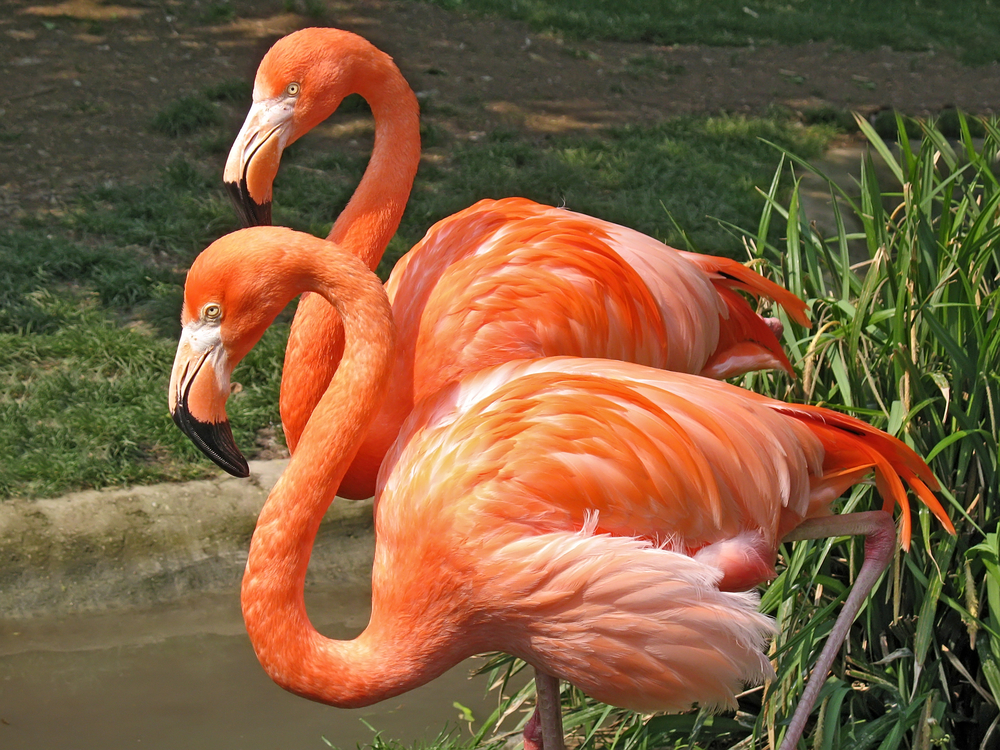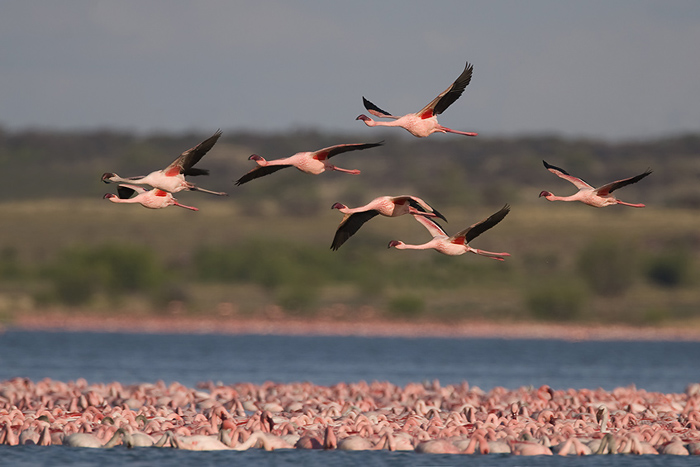Flamingo Facts: Food Turns Feathers Pink

Flamingos are large birds that are identifiable by their long necks, sticklike legs and pink or reddish feathers. Flamingos embody the saying "you are what you eat." The pink and reddish colors of a flamingo's feathers come from eating pigments found in algae and invertebrates.
There are six species of flamingo, according to the Integrated Taxonomic Information System (ITIS): greater flamingo, lesser flamingo, Chilean flamingo, Andean flamingo, James' (or puna) flamingo and American (or Caribbean) flamingo.
The greater flamingo is the tallest species. It stands 3.9 to 4.7 feet (1.2 to 1.45 meters) and weighs up to 7.7 lbs. (3.5 kilograms), according to Sea World. The shortest species is the lesser flamingo, which stands 2.6 feet (80 cm) and weighs 5.5 lbs. (2.5 kg). The wingspan of flamingos ranges from 37 inches (95 cm) to 59 inches (150 cm).
Habitat
American flamingos live in the West Indies, Yucatán, in the northern part of South America and along the Galapagos Islands. Chilean, Andean and James' flamingos live in South America, and the greater and lesser flamingos live in Africa. Greater flamingos can also be found in the Middle East and India.
Flamingos are water birds, so they live in and around lagoons or lakes. These bodies of water tend to be saline or alkaline. Flamingos are generally nonmigratory, but changes in climate or water levels in their breeding areas will cause them to relocate, according to Sea World.
Diet
Flamingos eat larva, small insects, blue-green and red algae, mollusks, crustaceans and small fish, according to Sea World. Their tendency to eat both vegetation and meat makes them omnivores.
Flamingos are pink because the algae they consume are loaded with beta carotene, an organic chemical that contains a reddish-orange pigment. (Beta carotene is also present in many plants, but especially in tomatoes, spinach, pumpkins, sweet potato and, of course, carrots.) The mollusks and crustaceans flamingos snack on contain similar pigment-packing carotenoids.
Get the world’s most fascinating discoveries delivered straight to your inbox.
Carotenoid levels in their food vary in different parts of the world, which is why American flamingos are usually bright red and orange, while lesser flamingos of the drought-plagued Lake Nakuru in central Kenya tend to be a paler pink.
If a flamingo were to stop eating food containing carotenoids, its new feathers would begin growing in with a much paler shade, and its reddish feathers would eventually molt away. Molted feathers lose their pinkish hue.
What a flamingo eats depends on what type of beak it has. Lesser, James' and Andean flamingos have what is called a deep-keeled bill. They eat mostly algae. Greater, Chilean and American flamingos have shallow-keeled bills, which allow them to eat insects, invertebrates and small fish.
To eat, flamingos will stir up the bottom of the lake with their feet and duck their beaks down into the mud and water to catch their meal.
Habits
Groups of flamingos are called colonies or flocks. The colony works together to protect each other from predators and to take care of the young.
It is believed that flamingos are monogamous, according to Sea World. Once they mate, they tend to stay with that mate. A group of flamingos will all mate at the same time so that all of the chicks will hatch at the same time. Pairs will make nests out of mounds of mud, and the female will lay one egg at a time, according to the Smithsonian National Zoo.
Each egg is a little bigger than a large chicken egg, at 3 to 3.5 inches (78 to 90 millimeters) long and 4 to 4.9 ounces (115 to 140 grams). The egg will take 27 to 31 days to hatch, and the emerging chick will only be 2.5 to 3.2 ounces (73 to 90 g). Young reach maturity at 3 to 5 years old.
Baby flamingos are gray or white. They will turn pink within the first couple years of life. Flamingos live 20 to 30 years in the wild or up to 50 years in a zoo.
Two adorable flamingo chicks were born this month at the Smithsonian's National Zoo in Washington, D.C. The baby birds were the 100th and 101st flamingo chicks to hatch at the zoo's Bird House. Since flamingo chicks have a higher survival rate if they are hand-reared, zookeepers are keeping the babies out of the spotlight for now. When they are older, the birds will join the zoo's flock of flamingoes outside, according to Smithsonian officials. [Related Gallery: World's Cutest Baby Wild Animals] Credit: Madelyn Duhon/Smithsonian's National Zoo
Classification/Taxonomy
The taxonomy of flamingos, according to ITIS, is:
Kingdom: Animalia Phylum: Chordata Class: Aves Order: Phoenicopteriformes Family: Phoenicopteridae Genera: Phoeniconaias, Phoenicoparrus, Phoenicopterus Species:
- Phoeniconaias minor (Lesser flamingo)
- Phoenicoparrus andinus (Andean flamingo)
- Phoenicoparrus jamesi (James' flamingo or puna flamingo)
- Phoenicopterus chilensis (Chilean flamingo)
- Phoenicopterus roseus (Greater flamingo)
- Phoenicopterus ruber (American flamingo or Caribbean flamingo)
Conservation Status
According to International Union for Conservation of Nature's Red List of Threatened Species, no flamingo species is currently considered endangered. The lesser, Chilean and James'flamingos are considered near threatened because their numbers are small or decreasing, according to the IUCN.
Other facts
Fossil evidence indicates that the group from which flamingos evolved is very old and existed about 30 million years ago, before many other avian orders had evolved, according to Sea World.
It isn't really known why flamingos tend to stand on one foot, but it has been hypothesized that keeping one of their feet out of the cold water helps them to conserve body heat. It also seems to be a comfortable resting position for them.
Though it is believed that flamingos are tropical birds, they can also live and thrive in cold environments as long as they have access to plenty of water and food.
In East Africa, more than 1 million flamingos have been known to gather together, forming the largest flock known, according to the Philadelphia Zoo.
Other resources:




![Two adorable flamingo chicks were born this month at the Smithsonian's National Zoo in Washington, D.C. The baby birds were the 100th and 101st flamingo chicks to hatch at the zoo's Bird House.Since flamingo chicks have a higher survival rate if they are hand-reared, zookeepers are keeping the babies out of the spotlight for now. When they are older, the birds will join the zoo's flock of flamingoes outside, according to Smithsonian officials. [Related Gallery: World's Cutest Baby Wild Animals]](https://cdn.mos.cms.futurecdn.net/BtSqMfo4sTwDBnZj9GRthA.jpeg)
